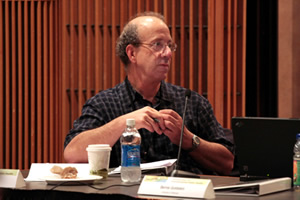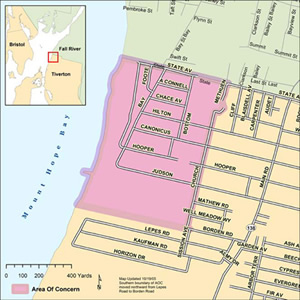
Environmental Factor, August 2008, National Institute of Environmental Health Sciences
Superfund Puts Trust at the Top in Rhode Island Project
By Eddy Ball
August 2008


An article published in the July 1 issue of Environmental Science and Technology by scientists in the Brown University Superfund Basic Research Program (SBRP) reports on a successful collaboration between a multi-disciplinary research program and community representatives of a contaminated neighborhood in Tiverton, R.I. The report demonstrates the ways that building trust through a multi-stakeholder approach can help residents start to regain the control they feel has been lost because of environmental damage to their communities — and benefit from the scientific research, government programs and community resources that can help them.
The article (http://pubs.acs.org/cgi-bin/abstract.cgi/esthag/2008/42/i13/abs/es7023498.html) ![]() is the latest of 24 publications to emerge from Reuse In Rhode Island: A State-based Approach to Complex Exposures (http://www.brown.edu/Research/SBRP/)
is the latest of 24 publications to emerge from Reuse In Rhode Island: A State-based Approach to Complex Exposures (http://www.brown.edu/Research/SBRP/) ![]() , a four-year SBRP project funded in 2005 by NIEHS. Reuse in Rhode Island has a multifaceted focus, addressing the synergistic toxicity of mixed exposures, developing novel strategies and materials for remediation and mounting a community outreach and empowerment initiative to engage residents in a program to remediate hazardous waste sites in their neighborhoods.
, a four-year SBRP project funded in 2005 by NIEHS. Reuse in Rhode Island has a multifaceted focus, addressing the synergistic toxicity of mixed exposures, developing novel strategies and materials for remediation and mounting a community outreach and empowerment initiative to engage residents in a program to remediate hazardous waste sites in their neighborhoods.
According to the researchers, the outreach core was able to build upon an established long-term relationship with the community-based group Environmental Neighborhood Awareness Committee of Tiverton (ENACT) (http://www.enactri.org/) ![]() . Tiverton is a town located in the East Bay section of Rhode Island between Aquidneck Island and Fall River, Mass.
. Tiverton is a town located in the East Bay section of Rhode Island between Aquidneck Island and Fall River, Mass.
Residents of the Bay Street neighborhood of Tiverton were shocked to learn in August 2002 that a municipal crew had discovered soil and sediment contaminated by cyanide, lead, arsenic and other toxicants from a nearby coal gasification plant. Like other residents of contaminated areas, many in the Bay Street neighborhood fell prey to the stress, distrust and frustration that can come with living in a contaminated area where property values suddenly drop dramatically. Because the Bay Street neighborhood was not designated a Superfund site, there was no realistic way for most property owners to recoup their losses.
According to the researchers, people in this situation come to distrust virtually everyone — government officials, academic researchers and other outsiders. This distrust can be one of the greatest barriers to conducting and translating the kind of research that can lead to remediation and restore lost property value. The Brown team sought to overcome this barrier by partnering with ENACT. In addition to the “professional-to-professional” communication that is a model commonly used by research programs, the SBRP outreach core focused on developing effective ways to facilitate “professional-to-community” communication.
Armed with Brown’s research on mixed exposures, ENACT mounted an aggressive lobbying campaign with the state legislature, culminating in enactment of the Environmentally Compromised Home Opportunity (ECHO) Loan bill in July 2006. ECHO is the brainchild of Professor of Sociology and Environmental Studies Phil Brown, Ph.D., and two of his undergraduate students, and they along with the entire community outreach team, including Laura Senier, first author for the paper, worked to make the aid program a reality. ECHO is an innovative state program that lends up to $25,000 at relatively low interest rates to residents of areas affected by toxic chemicals and represents a first step toward restoration of the neighborhood.
While the loans have been helpful, for many residents they are still far from adequate. The Brown SBRP team met with state legislators and staff from Rhode Island Housing in the fall of 2007 to craft an agreement to find a way to amend the program, and the scientists continue to collaborate with ENACT to achieve effective cleanup and restoration. The team is also working to disseminate information about their project’s successes to other states where the Rhode Island model of trust building, research translation and outreach could benefit similar communities — as well as to researchers designing any type of research project with an outreach component.
Citation: Senier L, Hudson B, Fort S, Hoover E, Tillson R, and Brown P. 2008. Brown Superfund Basic Research Program: A Multistakeholder Partnership Addresses Real-World Problems in Contaminated Communities. Environ Sci Technol 42(13):4655–4662. 10.1021/es7023498
"Superfund Grantee Hammock Honored..." - previous story ![]()
![]() next story - "2008 Green Technology..."
next story - "2008 Green Technology..."
August 2008 Cover Page



